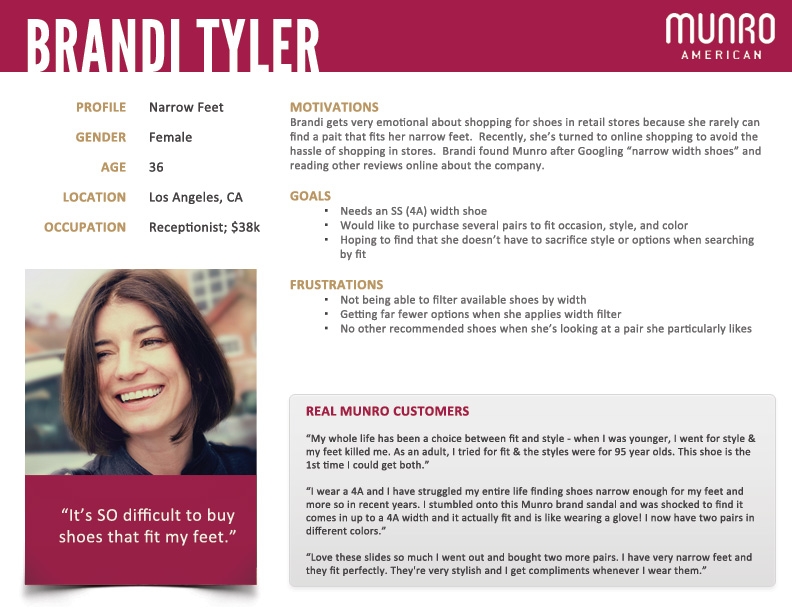 I’m a huge fan of using personas to help drive strategy and tactics, as you probably know from recent blog posts. It always surprised me, however, that many traditional marketers (outside of the food and beverage industries) shy away from personas. In most cases, it’s a lack of understanding and an old-fashioned perception. Here are the main misconceptions about creating and using personas I’ve run across with marketers
I’m a huge fan of using personas to help drive strategy and tactics, as you probably know from recent blog posts. It always surprised me, however, that many traditional marketers (outside of the food and beverage industries) shy away from personas. In most cases, it’s a lack of understanding and an old-fashioned perception. Here are the main misconceptions about creating and using personas I’ve run across with marketers
- Personas don’t describe behavior, so they’re useless for targeting. If you’re really trying to boost your marketing communications results, personas must contain a huge amount of information about behavior. If you’re involved in influencer marketing, you need to know where those influencers receive their information. If you’re selling glasses, you need to understand the common problems experienced by those in spectacles. Some (mainly traditional) marketers only think of their customers in terms of demographics, psychographics and possibly values. They don’t understand how to analyze for behavior and therefore are unable to add that information to their personas.
- Digital marketing is all about the numbers therefore personas are irrelevant. On the flip side of this argument, we have a large number of digital marketers who insist that everything can be achieved if you analyze your quantitative results often enough. This is the “blast” approach, where you’re making changes to influence some kind of conversion but you really know nothing about the actual people buying your product or reading your content other than when they are more likely to read it and which message is most likely to convert. Arriving at this information is a failing forward process that takes a lot of time and testing. Personas move the starting line much further ahead and help you get to the results much more quickly.
- Personas are too narrow and you’ll miss customers. This is the old-fashioned argument that we’ve been hearing for years. What happens if you choose the wrong personas? What if you’ve missed the mark on your target customers? I would argue that it’s much easier to move the target than it is to blindly shoot thousands of arrows at once. I have chosen the wrong persona many times, but that exercise has helped me reach the right persona much faster than if I’m trying chase after a wide demographic. Plus, messaging to a huge target audience is impossible. It becomes so generic, it’s worthless. Better to aim and shoot your arrow at a few targets at a time, refining as you go. Have some confidence in your experience and intuition to create your first set of personas.
- Personas are fine for B2C but won’t work for B2B. Many of the persona conversations I’ve had with my B2B clients often downgrade into an endless argument about specifics like name, age, etc. This is often because B2B still relies heavily on a field sales force who like to regard every client experience as unique. Developing those human connections that are crucial to sales means that cookie cutter approaches (as personas are often viewed) wont’ work. It’s a massive reason why sales adoption of marketing content is so low, and why they still develop their own slide decks. Within a B2B environment, sales and marketing needs to understand that personas can help get them to that face-to-face encounter more quickly. They don’t supplant the human connection, they just help us get there faster.
- You need to meet real customers, not hide behind fake personas. This is an argument I hear often, surprisingly from many content marketers. The problem is, you can’t meet all your real customers. And the ones you CAN meet might not be enough of a sample to derive the type of behavioral information you need to drive strategy. I personally hate focus groups because I believe people are influenced within the group and are not always telling their honest opinion. I feel the same way about real customers except in one case – when they’re mad. When customers are angry, you get the best information possible. More on that later.
I’ve read in several places that personas provide the bridge between quantitative and qualitative analysis, and I think that’s a beautiful way to describe their power. But they must be great personas and that takes some time and skill. If you’re wondering how to get started with personas, Hubspot has a nice set of questions along with a template.
How do you use personas in your work? Love them? Hate them? Let me know why!
Read More: Stats to Prove the Value of Personas